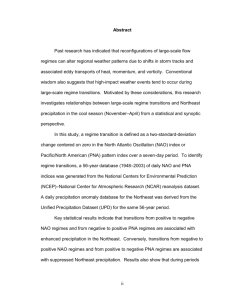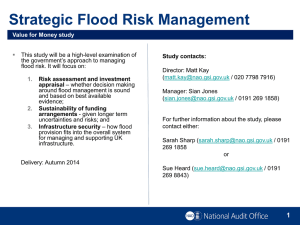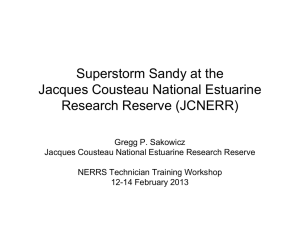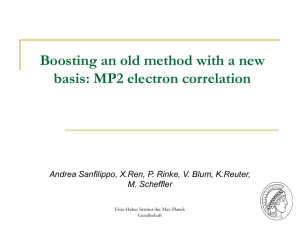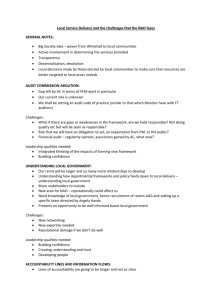Chapter 2
advertisement
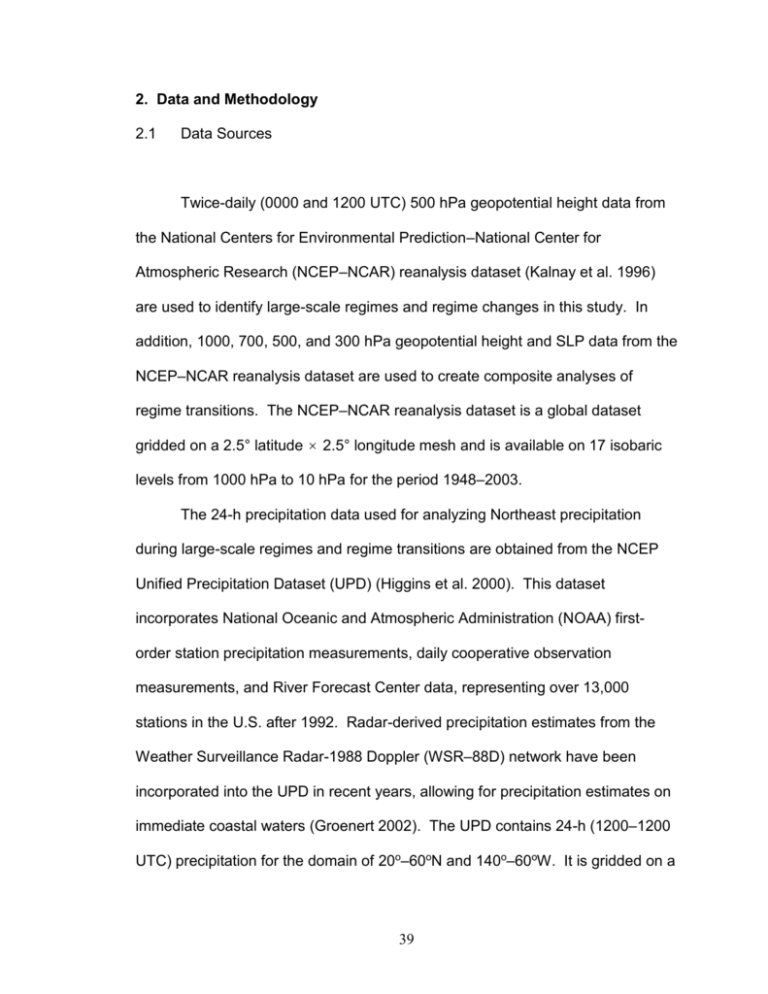
2. Data and Methodology 2.1 Data Sources Twice-daily (0000 and 1200 UTC) 500 hPa geopotential height data from the National Centers for Environmental Prediction–National Center for Atmospheric Research (NCEP–NCAR) reanalysis dataset (Kalnay et al. 1996) are used to identify large-scale regimes and regime changes in this study. In addition, 1000, 700, 500, and 300 hPa geopotential height and SLP data from the NCEP–NCAR reanalysis dataset are used to create composite analyses of regime transitions. The NCEP–NCAR reanalysis dataset is a global dataset gridded on a 2.5° latitude 2.5° longitude mesh and is available on 17 isobaric levels from 1000 hPa to 10 hPa for the period 1948–2003. The 24-h precipitation data used for analyzing Northeast precipitation during large-scale regimes and regime transitions are obtained from the NCEP Unified Precipitation Dataset (UPD) (Higgins et al. 2000). This dataset incorporates National Oceanic and Atmospheric Administration (NOAA) firstorder station precipitation measurements, daily cooperative observation measurements, and River Forecast Center data, representing over 13,000 stations in the U.S. after 1992. Radar-derived precipitation estimates from the Weather Surveillance Radar-1988 Doppler (WSR–88D) network have been incorporated into the UPD in recent years, allowing for precipitation estimates on immediate coastal waters (Groenert 2002). The UPD contains 24-h (1200–1200 UTC) precipitation for the domain of 20o–60oN and 140o–60oW. It is gridded on a 39 0.25° latitude 0.25° longitude mesh and is available for the period 1948–2003. The UPD may be obtained at ftp://ftpprd.ncep.noaa.gov/pub/precip/wd52ws/unified/. 2.2 Definition of a Large-Scale Regime Many types of large-scale patterns referenced in the general circulation literature may be considered to be regimes. Some examples of large-scale regimes are high- and low-index flows (e.g., Rossby 1939; Rossby and Willett 1948; Namias 1950), blocking (e.g., Rex 1950a; Colucci 1985; Colucci 1987), persistent high and low pressure circulation anomalies (e.g., Dole 1986), and teleconnection patterns such as the NAO and PNA (e.g., Wallace and Gutzler 1981; Barnston and Livezey 1987). In this study, large-scale regimes are objectively defined using teleconnection indices for several reasons. First, research studies have shown that teleconnection patterns significantly influence extratropical NH large-scale variability (e.g., Barnston and Livezey 1987, Ambaum et al. 2001; Quadrelli and Wallace 2004a). Second, the phases of teleconnection patterns can be associated with specific regional regimes (e.g., Leathers et al. 1991; Hurrell 1995). Third, teleconnection indices are widely used as first-order approximations of large-scale patterns. Teleconnection indices are easily accessible online at the NOAA–Cooperative Institute for Research in Environmental Sciences (CIRES) Climate Diagnostics Center (CDC) website (http://www.cdc.noaa.gov/map/wx/indices.shtml), and at the NOAA/National 40 Weather Service (NWS) Climate Prediction Center (CPC) website (http://www.cpc.ncep.noaa.gov/products/precip/CWlink/all_index.html). Following Groenert (2002), the positive and negative phases of the NAO and the PNA have been chosen to represent four different large-scale regimes. The NAO pattern is used instead of the AO/NAM pattern in this research because the more regional spatial extent and the proximity of the domain of the NAO to the northeastern U.S. imply that the NAO may have a greater influence on precipitation in the northeastern U.S. than does the AO/NAM. For use in the objective identification of large-scale regimes and regime transitions, daily indices of the NAO and PNA are produced for a 56-year period from 1 January 1948 through 31 December 2003 using daily 500 hPa geopotential height data from the NCEP–NCAR reanalysis dataset. The spatial domains used to calculate the daily teleconnection indices are the same domains used by the CDC and correspond to the loading pattern identified through REOF analysis of NH 500 hPa geopotential height (Barnston and Livezey 1987). Examples of the loading patterns of the positive phase of the NAO and the positive phase of the PNA obtained through REOF analysis are shown in Figs. 2.1 and 2.2, respectively. Identical to the domains used by the CDC to calculate daily NAO indices, the two domains used to calculate NAO indices for this study are shown in Fig. 2.3 as the North (N) domain (55°–70°N, 70°–10°W) and the South (S) domain (35°–45°N, 70°–10°W). The four domains of the PNA used in this study are also identical to the PNA domains used by the CDC. The PNA domains are shown in 41 Fig. 2.4 as the Hawaii (HI) domain (15°–25°N, 180°–140°W), the Alaska (AK) domain (40°–50°N, 180°–140°W), the Pacific Northwest (NW) domain (45°– 60°N, 125°–105°W ), and the southeastern U.S. (SE) domain (25°–35°N, 90°– 70°W). The procedure to compute a time series of daily normalized NAO indices is as follows: First, daily values of area-weighted domain-average 500 hPa geopotential height are computed for the N and S domains of the NAO using 0000 UTC and 1200 UTC data. Second, the daily domain-average 500 hPa geopotential height data are normalized by subtracting 15-day long-term (i.e., for the entire time series) climatological geopotential heights centered on each day of the year from the daily geopotential heights and dividing by the 15-day longterm standard deviation (Wilks 1995, p. 81). Third, a time series of normalized NAO indices are created by subtracting the N domain daily normalized geopotential heights from the S domain daily normalized geopotential heights. Finally, a daily time series of standardized and normalized NAO indices is obtained by dividing the daily values of the NAO index time series by the standard deviation of the entire index time series. For the purposes of this study, a positive NAO regime corresponds to a NAO index value greater than or equal to +1 standard deviation from the mean of the entire index time series, while a negative NAO regime corresponds to a NAO index value less than or equal to −1 standard deviation from the mean. The spatial pattern of the NAO shown in Fig. 2.1 can be interpreted as showing the composite 500 hPa geopotential height anomaly field for a positive NAO regime. 42 From a synoptic perspective, then, a positive NAO regime is indicative of a strong latitudinal midtropospheric geopotential height gradient over the North Atlantic relative to climatology. Assuming that the speed of the actual wind is close to the speed of the geostrophic wind at in the middle troposphere, a positive NAO regime corresponds to stronger-than-average midtropospheric westerlies over the North Atlantic. Conversely, a negative NAO index value indicates a weak latitudinal midtropospheric geopotential height gradient over the North Atlantic relative to climatology, and may be associated with weaker-thanaverage midlevel westerlies over the North Atlantic. The procedure to compute a time series of daily normalized PNA indices is similar to the procedure used to compute the time series of daily normalized NAO indices. First, a daily time series of the differences in normalized geopotential heights between the HI and AK domains is obtained by repeating steps 1–3 of the procedure for calculating the NAO time series, with the HI domain replacing the S domain and the AK domain replacing the N domain. Second, a daily time series of the differences in normalized geopotential heights between the NW and SE domains is obtained by again repeating steps 1–3 with the NW domain replacing the S domain and the SE domain replacing the N domain. Third, a time series of normalized PNA indices is created by adding the daily values of the HI − AK time series to the daily values of the NW − SE time series. Finally, a time series of standardized and normalized PNA indices is obtained by dividing the daily values of the PNA index time series by the standard deviation of the entire time series. 43 Similar to a positive and negative NAO regime, a positive PNA regime corresponds to a PNA index value greater than or equal to +1 standard deviation from the mean, while a negative PNA regime corresponds to a PNA index value less than or equal to −1 standard deviation from the mean. The spatial pattern of the PNA shown in Fig. 2.2 can be interpreted as showing the mean 500 hPa geopotential height anomaly field for a positive PNA regime. From a synoptic perspective, then, a positive PNA regime indicates an amplified pattern with respect to climatology, with a positive midtropospheric geopotential height anomaly centered over Alberta, Canada and a negative midlevel geopotential height anomaly centered over the southeastern U.S. Conversely, a negative PNA regime indicates a zonal pattern with respect to climatology, with a negative midtropospheric geopotential height anomaly centered over Alberta, Canada, and a positive midtropospheric geopotential height anomaly centered over the southeastern U.S. The normalized NAO and PNA index time series calculated for use in this study are highly linearly correlated with the CPC’s NAO and PNA index time series, respectively, which may be downloaded at ftp://ftpprd.ncep.noaa.gov/pub/cpc/cwlinks/. The CPC’s normalized daily NAO and PNA indices are constructed by projecting the daily 0000 UTC 500 hPa NH geopotential height anomalies onto the loading patterns of the NAO and PNA (Figs. 2.1 and 2.2, respectively). Simple linear regression of the two NAO time series for a 54-year period from 1 January 1950 through 31 December 2003 44 yields a correlation coefficient of 0.84, while simple linear regression of the two PNA time series for the same period yields a correlation coefficient of 0.81. 2.3 Definition of a Large-Scale Regime Transition Based on the definitions of large-scale regimes detailed above, a regime transition is defined as a transition from a negative to positive regime or positive to negative regime over a seven-day period. The requirement of a regime transition time of seven days is chosen in order to identify only the most rapid regime transitions, which may be more easily linked to transient synoptic-scale disturbances. In addition, the requirement of a seven-day regime transition period is consistent with research indicating an intrinsic time scale of about 10 days for the NAO (Feldstein 2003) and PNA (Cash and Lee 2001). 2.4 Calculation of Northeast Precipitation Anomalies For use in determining composite Northeast precipitation anomalies during large-scale regimes and regime transitions, normalized seven-day running precipitation anomalies are calculated for the Northeast from the UPD 24-h precipitation data using the following procedure. First, a 56-year time series (1 January 1948–31 December 2003) of running seven-day domain-average precipitation totals is created using the Northeast domain shown in Fig. 2.5. Second, since seven-day domain-average Northeast precipitation totals are 45 found to be positively skewed over time, a simple square-root power transformation, T(x) = x1/2 (Wilks 1995, p. 39), is applied to the time series of running seven-day domain-average Northeast precipitation totals to create a precipitation time series with an approximately normal distribution. Finally, the transformed seven-day running precipitation totals for each day in the 56-year time series are standardized by first subtracting from each day’s transformed seven-day running precipitation total the climatological mean of the transformed precipitation total centered on that date, and then dividing by the climatological standard deviation of the transformed precipitation total centered on that date. 46 Fig. 2.1. The loading pattern of the NAO shown as the first-leading REOF of NH mean monthly 500 hPa geopotential height (from the CPC). Units are nondimensional. Fig. 2.2. The loading pattern of the PNA shown as the second-leading REOF of NH mean monthly 500 hPa mean monthly height (from the CPC). Units are nondimensional. 47 Fig. 2.3. The N and S domains of the NAO used to create a daily NAO time series. Fig. 2.4. The HI, AK, NW, and SE domains of the PNA used to create a daily PNA time series. 48 Fig. 2.5. The domain used to calculate Northeast precipitation anomalies. 49
